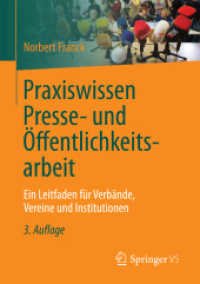Full Description
In 1918, when Henry Blake Fuller was 62 years old, he completed the manuscript of a novel, Bertram Cope's Year. Though Fuller was well known as an accomplished realist and had published twelve previous novels, this work was his first published fiction to address the topic of homosexuality. In the novel Bertram Cope, a handsome young college student, is befriended by Medora Phillips, a wealthy older woman who tries to match him with several eligible young women. However, Bertram is emotionally attached only to his friend and housemate, Arthur Lemoyne. The novel's portrayal of their friendship is subtle, but has clear overtones of sexual attraction.
Appendices focus on the novel's composition, reception, and place in contemporary discourses about attraction between men.
Contents
Acknowledgements
Introduction
Henry Blake Fuller: A Brief Chronology
A Note on the Text
Bertram Cope's Year
Appendix A: Fuller's Emendations to Bertram Cope's Year
Appendix B: From Anatole France, The Garden of Epicurus (1923)
Appendix C: Writings by Henry Blake Fuller
From Edmund Dalrymple (1904)
At Saint Judas's from The Puppet Booth: Twelve Plays (1896)
"When Robert Sings" (n.d.)
Appendix D: Fuller's Diary Entries, 1874-79
From "A Legacy to Posterity" (1874-79)
From "Allison Classical Academy" (1875)
Appendix E: Contemporary Reviews
Burton Rascoe, Chicago Tribune (8 November 1919)
Unsigned Review, Boston Evening Transcript (13 November 1919)
Llewellyn Jones, "Henry B. Fuller Portrays Youth and Would-Be Youth," Chicago Evening Post (28 November 1919)
Unsigned Review, "Under the Microscope," The Boston Post (n.d.)
H.L. Mencken, "The Flood of Fiction," The Smart Set (January 1920)
Keith Preston, "North of Chicago," "The Periscope," Chicago Daily News (n.d.)
From Carl Van Vechten, "Henry Blake Fuller," Excavations: A Book of Advocacies (1926)
Selected Bibliography








